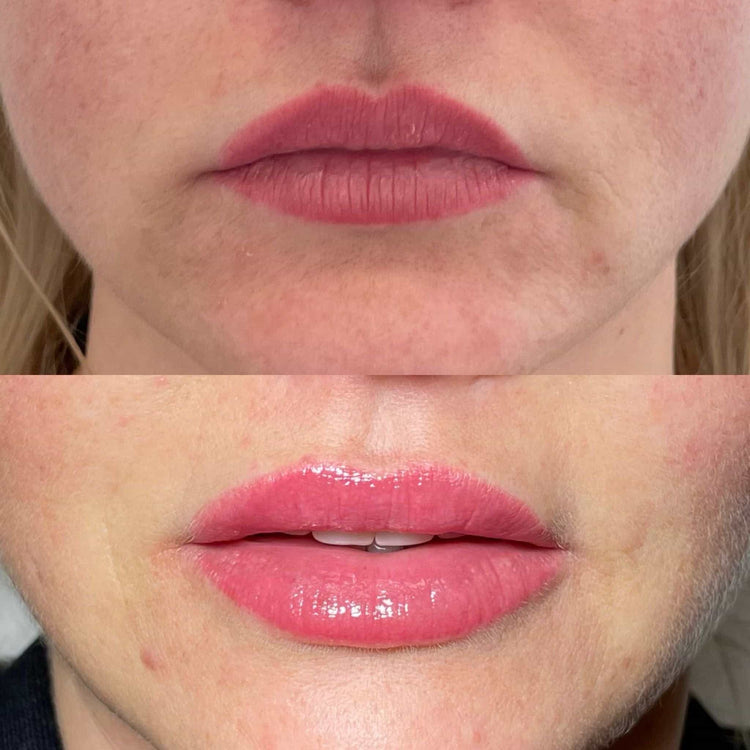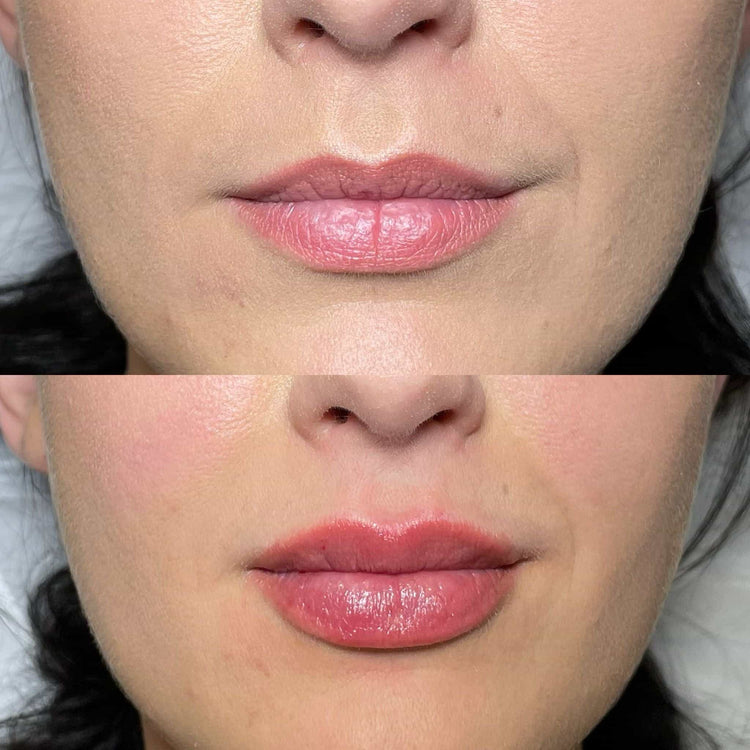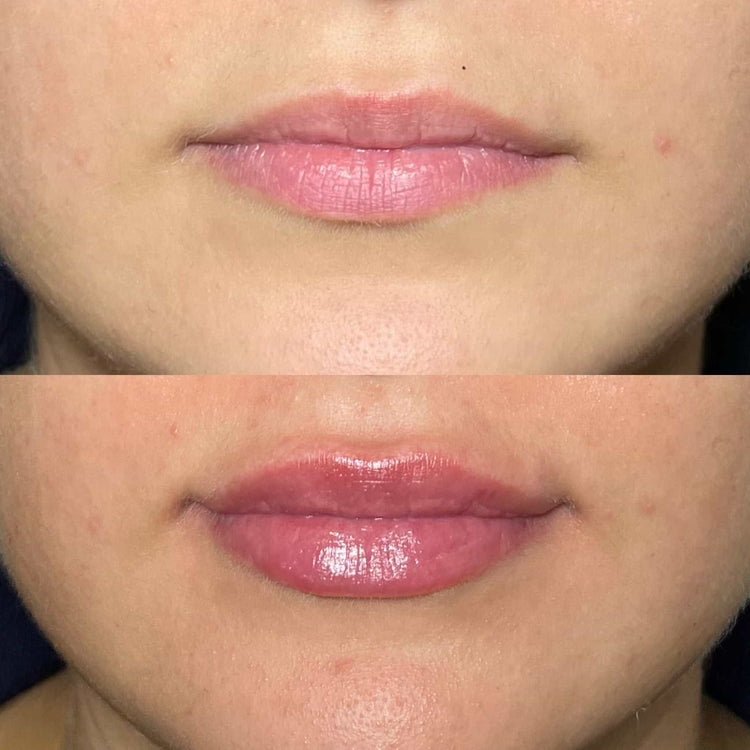Types of Lip Filler
Lip fillers have become increasingly popular in recent years, offering a non-surgical way to enhance lip shape, size, and definition. A variety of dermal fillers are available in the UK, each with its own unique properties and benefits. From hyaluronic acid-based fillers to those containing calcium hydroxylapatite, understanding the different types is crucial for making an informed decision about achieving desired lip enhancement results.

Hyaluronic Acid Fillers
Hyaluronic acid (HA) fillers are a popular choice for lip augmentation due to their ability to attract and retain moisture. HA is a naturally occurring substance in the body that helps keep skin hydrated and plump. When injected, HA fillers add volume to the lips, smoothing fine lines and wrinkles while enhancing shape and fullness. Different HA fillers have varying viscosities and densities, allowing practitioners to tailor treatment to individual needs. Some popular HA fillers include Juvederm, Restylane, and Belotero.
Calcium Hydroxyapatite Fillers
Calcium hydroxyapatite (CaHA) fillers are another type of dermal filler gaining popularity for lip augmentation in the UK.
- CaHA fillers are made from microspheres of calcium hydroxyapatite, a naturally occurring mineral found in bones and teeth.
- These microspheres stimulate collagen production when injected into the lips, leading to a more natural-looking enhancement that gradually improves over time.
- CaHA fillers are also known for their long-lasting results, often providing volume and definition for up to 12 months or longer.
Poly-L-Lactic Acid (PLLA) Fillers
Poly-L-Lactic Acid (PLLA) fillers are a unique type of dermal filler that works differently than hyaluronic acid or calcium hydroxyapatite.
- PLLA fillers are made from biodegradable polylactic acid, a synthetic material that is gradually absorbed by the body.
- Instead of providing immediate volume like HA fillers, PLLA stimulates collagen production over time.
- This gradual collagen stimulation leads to a natural-looking enhancement and long-lasting results, often lasting for 18 months or more.
Choosing the Right Filler
Choosing the right lip filler is essential for achieving desired results and ensuring safety. The UK market offers a variety of dermal fillers, each with unique properties and benefits. Understanding the differences between hyaluronic acid fillers, calcium hydroxyapatite fillers, and poly-L-lactic acid fillers will empower individuals to make informed decisions about their lip enhancement journey.
Factors to Consider
When choosing the right lip filler, several factors should be taken into consideration. Firstly, it’s important to determine the desired outcome. Are you looking for subtle enhancement, increased volume, or correction of asymmetries? Different fillers offer varying degrees of lift and volume.
The longevity of the results is another crucial factor. Hyaluronic acid fillers typically last 6-18 months, while calcium hydroxyapatite fillers can provide long-lasting results for up to a year or longer. Poly-L-lactic acid fillers stimulate collagen production, offering lasting enhancement that can last for 18 months or more.
The type of skin and individual anatomy also play a role. For instance, those with thin lips might benefit from a more volumizing filler, while individuals with sensitive skin may prefer a gentler option like hyaluronic acid.
It’s essential to consult with a qualified and experienced practitioner who can assess your needs and recommend the most suitable filler type and treatment plan.
Desired Results
Choosing the right lip filler depends on individual needs and desired outcomes. Hyaluronic acid fillers are popular for their ability to add volume and hydration, with varying levels of density for different results. Calcium hydroxyapatite fillers stimulate collagen production for a more natural-looking enhancement that lasts longer. Poly-L-lactic acid fillers work gradually by stimulating collagen over time, offering long-lasting results.
Factors to consider include desired volume and lift, longevity of results, skin type, and individual anatomy. Consulting with a qualified practitioner is crucial for determining the most suitable filler and treatment plan.
Skin Type
Choosing a lip filler depends heavily on your skin type and desired outcome.
Those with oily skin may find hyaluronic acid fillers last longer, while dry skin types might benefit from a more hydrating option. Individuals with sensitive skin should consider gentle hyaluronic acid fillers or discuss alternative options with a practitioner.
Understanding the properties of each filler type is crucial. Hyaluronic acid fillers are known for their immediate volume and hydration, making them suitable for those seeking subtle enhancements or addressing fine lines around the lips. Calcium hydroxyapatite fillers, on the other hand, stimulate collagen production for a more gradual, natural-looking enhancement that lasts longer.
Poly-L-lactic acid fillers work by stimulating collagen over time, offering long-lasting results but requiring multiple treatments to achieve desired volume. It’s important to consult with a qualified practitioner to determine the best filler type and treatment plan based on your individual needs and skin characteristics.
Medical History
Medical history plays a crucial role in choosing the right lip filler. Certain medical conditions or medications can influence how a patient responds to dermal fillers.
For example, individuals with bleeding disorders or those taking blood thinners might be advised against certain types of fillers due to an increased risk of bruising or bleeding. Patients with autoimmune diseases may also require careful consideration as some fillers could trigger adverse reactions.
A thorough medical history review allows the practitioner to assess potential risks and contraindications, ensuring a safe and effective treatment experience.
Consultation with a Qualified Practitioner
Choosing the right filler is essential for achieving desired results and ensuring safety. When choosing the right lip filler, several factors should be taken into consideration. Firstly, it’s important to determine the desired outcome. Are you looking for subtle enhancement, increased volume, or correction of asymmetries? Different fillers offer varying degrees of lift and volume.
The longevity of the results is another crucial factor. Hyaluronic acid fillers typically last 6-18 months, while calcium hydroxyapatite fillers can provide long-lasting results for up to a year or longer. Poly-L-lactic acid fillers stimulate collagen production, offering lasting enhancement that can last for 18 months or more.
The type of skin and individual anatomy also play a role. For instance, those with thin lips might benefit from a more volumizing filler, while individuals with sensitive skin may prefer a gentler option like hyaluronic acid.
It’s essential to consult with a qualified and experienced practitioner who can assess your needs and recommend the most suitable filler type and treatment plan.
Benefits of Lip Fillers
Lip fillers have become increasingly popular, offering a non-surgical way to enhance lip shape, size, and definition. The UK market offers a variety of dermal fillers, each with its own unique properties and benefits. Understanding these differences is crucial for making informed decisions about achieving desired lip enhancement results.
Increased Lip Volume and Definition
Lip fillers offer a non-surgical pathway to boost lip volume and definition.
- Increased lip volume provides a fuller appearance, enhancing the natural curves of the lips.
- Improved lip definition accentuates the cupid’s bow and border of the lips, creating a more symmetrical and defined shape.
Enhanced Facial Symmetry

Enhanced facial symmetry is one of the key benefits of lip fillers. When lips are uneven or disproportionate, it can affect the overall balance of the face. Lip fillers can be strategically used to add volume to one side or correct asymmetries, resulting in a more harmonious and aesthetically pleasing appearance.
Improved Self-Confidence
Lip fillers can significantly boost a person’s self-confidence. Feeling satisfied with one’s appearance often leads to increased self-esteem and a more positive self-image. The enhanced fullness and definition provided by lip fillers can make individuals feel more attractive and desirable, which can positively impact their overall confidence.
By addressing perceived flaws or insecurities about lip size or shape, lip fillers can empower individuals to feel more comfortable and confident in social situations. They may experience a newfound sense of self-assurance, leading to improved body language, better communication, and an increased willingness to engage with others.
Potential Risks and Side Effects
While lip fillers offer numerous aesthetic benefits, it’s crucial to be aware of potential risks and side effects associated with these procedures.
Bruising and Swelling
Bruising and swelling are common side effects of lip filler injections. These occur as a natural part of the body’s healing process after any kind of needle insertion.
Most bruising and swelling subsides within a few days to a week. However, in some cases, it may take longer to completely disappear. Applying ice packs to the treated area can help minimize swelling.

It’s important to avoid touching or rubbing the injected area as this can further irritate the skin and prolong healing.
While generally safe, lip fillers carry potential risks like allergic reactions, infection, or uneven results. Choosing a qualified and experienced practitioner who uses sterile techniques is essential for minimizing these risks.
Infection
Potential side effects of lip fillers can include bruising, swelling, redness, tenderness, and itching. These are typically temporary and resolve within a few days to weeks. In rare cases, more serious complications like infection, allergic reactions, or asymmetry can occur. It’s essential to consult with a qualified and experienced practitioner who uses sterile techniques and appropriate filler products to minimize these risks.
Choosing the right lip filler depends on individual needs and desired outcomes. Hyaluronic acid fillers are popular for their ability to add volume and hydration, with varying levels of density for different results. Calcium hydroxyapatite fillers stimulate collagen production for a more gradual, natural-looking enhancement that lasts longer. Poly-L-lactic acid fillers work by stimulating collagen over time, offering long-lasting results but requiring multiple treatments to achieve desired volume.
Allergic Reactions
Potential side effects of lip filler injections are generally mild and temporary. They include bruising, swelling, redness, tenderness, itching, and a slight tingling sensation around the injection site. These symptoms usually subside within a few days to a week.
More serious complications are rare but can occur. Allergic reactions to the filler material can happen, though they are uncommon. Signs of an allergic reaction may include hives, difficulty breathing, or swelling of the face or throat. Seek immediate medical attention if you experience any signs of an allergic reaction.
Infection is another potential risk associated with any procedure involving needle insertion. Proper sterilization techniques and post-treatment care instructions from your practitioner can minimize this risk. If you notice signs of infection, such as redness, swelling, warmth, or pus, contact your practitioner promptly.
Asymmetry is another potential concern. While experienced practitioners strive for symmetrical results, slight variations are possible. If you have concerns about asymmetry after treatment, discuss them with your practitioner.
Lumps and Bumps
Potential side effects of lip fillers vary depending on the individual and the type of filler used. Common side effects include bruising, swelling, redness, tenderness, itching, and a temporary feeling of tightness around the lips. These usually subside within a few days to a week.
More serious side effects are rare but can occur. Allergic reactions to the filler material are possible, though uncommon. Signs of an allergic reaction may include hives, difficulty breathing, or swelling of the face or throat. Seek immediate medical attention if you experience any signs of an allergic reaction.
Infection is a risk with any procedure involving needle insertion. Proper sterilization techniques and post-treatment care instructions from your practitioner can minimize this risk. If you notice signs of infection, such as redness, swelling, warmth, or pus, contact your practitioner promptly.
Asymmetry in lip shape is another potential concern. While experienced practitioners strive for symmetrical results, slight variations are possible. If you have concerns about asymmetry after treatment, discuss them with your practitioner.
Aftercare Instructions
Understanding the different types of lip fillers available in the UK is essential for making an informed decision about achieving desired lip enhancement results.
Initial Care
Lip fillers are a popular non-surgical option for enhancing lip shape, size, and definition. A variety of dermal fillers are available in the UK, each with its own unique properties and benefits.
Hyaluronic acid (HA) fillers are a common choice due to their ability to attract and retain moisture, plumping the lips and smoothing fine lines. They come in different viscosities and densities to suit individual needs.
Calcium hydroxyapatite (CaHA) fillers offer long-lasting results as they stimulate collagen production for a natural-looking enhancement.
Poly-L-lactic acid (PLLA) fillers work by gradually stimulating collagen over time, providing lasting volume that can last up to 18 months or more.
When choosing a lip filler, consider your desired outcome, longevity of results, skin type, and individual anatomy. Consult with a qualified practitioner who can assess your needs and recommend the best filler type for you.
Remember, potential side effects like bruising, swelling, redness, and tenderness are common and usually subside within a few days to a week. More serious complications are rare but seek immediate medical attention if you experience signs of infection, allergic reaction or asymmetry concerns.
Cold Compresses
Cold compresses can be helpful for managing post-treatment side effects such as swelling and bruising.
Apply a cold compress wrapped in a clean cloth to the treated area for 10-15 minutes at a time, several times a day. Avoid direct contact with ice, as it can damage the skin.
Avoiding Touching or Rubbing Lips
Aftercare instructions are crucial for ensuring optimal healing and results after lip filler treatment. One of the most important instructions is to avoid touching or rubbing your lips excessively.
Touching or rubbing the treated area can irritate the skin, disrupt the filler placement, and increase the risk of bruising and swelling. It’s best to keep your hands away from your lips as much as possible during the initial healing period.
Follow-Up Appointments
Aftercare instructions are crucial for ensuring optimal healing and results after lip filler treatment. One of the most important instructions is to avoid touching or rubbing your lips excessively. Touching or rubbing the treated area can irritate the skin, disrupt the filler placement, and increase the risk of bruising and swelling. It’s best to keep your hands away from your lips as much as possible during the initial healing period.
Another important aftercare instruction is to avoid applying makeup or other cosmetics to the treated area for at least 24 hours after treatment. This allows the skin to heal properly and reduces the risk of irritation or infection. You can gently cleanse the area with a mild cleanser and pat it dry once the initial swelling has subsided.
Follow-up appointments are essential for monitoring the results of lip filler treatment and addressing any potential concerns.
During the follow-up appointment, your practitioner will assess how well the filler has settled, check for any signs of complications, and discuss any adjustments that may be needed. These appointments typically occur a few weeks after the initial treatment, and additional appointments may be scheduled depending on individual needs and desired outcomes.
It’s important to attend all scheduled follow-up appointments to ensure optimal results and minimize potential risks associated with lip filler treatment.
Cost of Lip Fillers in the UK
The cost of lip fillers in the UK can vary significantly depending on several factors. These include:
* **Location:** Prices tend to be higher in London and other major cities compared to smaller towns and rural areas.
* **Practitioner’s experience and qualifications:** Highly experienced and qualified practitioners often charge more than those with less experience.
* **Type and volume of filler used:** Different types of fillers have different costs associated with them, and the volume needed will also affect the overall price.
* **Number of syringes used:** The amount of filler injected directly impacts the total cost.
* **Clinic fees and additional charges:** Some clinics may have consultation fees or charge for other services such as numbing cream or aftercare products.
On average, lip fillers in the UK can range from £200 to £700 per syringe. A single treatment usually requires one to two syringes, meaning the total cost could be anywhere between £400 and £1400.
Book your lip injection appointment with Dr. Laura Geige at It’s Me & You Clinic
- Can THC Soda Help With Hangovers? What You Should Know - May 9, 2025
- Botox For Dimpled Chin In Hampton, Surrey - May 9, 2025
- How Gaslighting Creates Confusion And Distrust In Relationships - May 8, 2025
